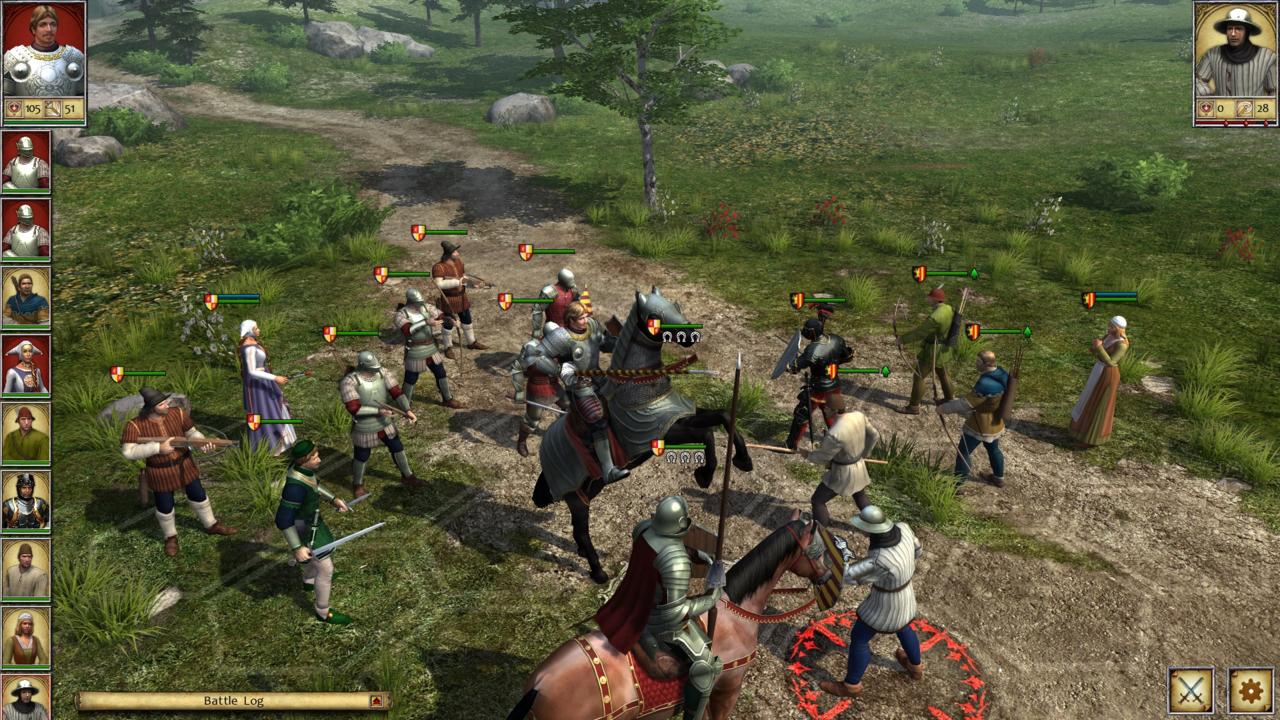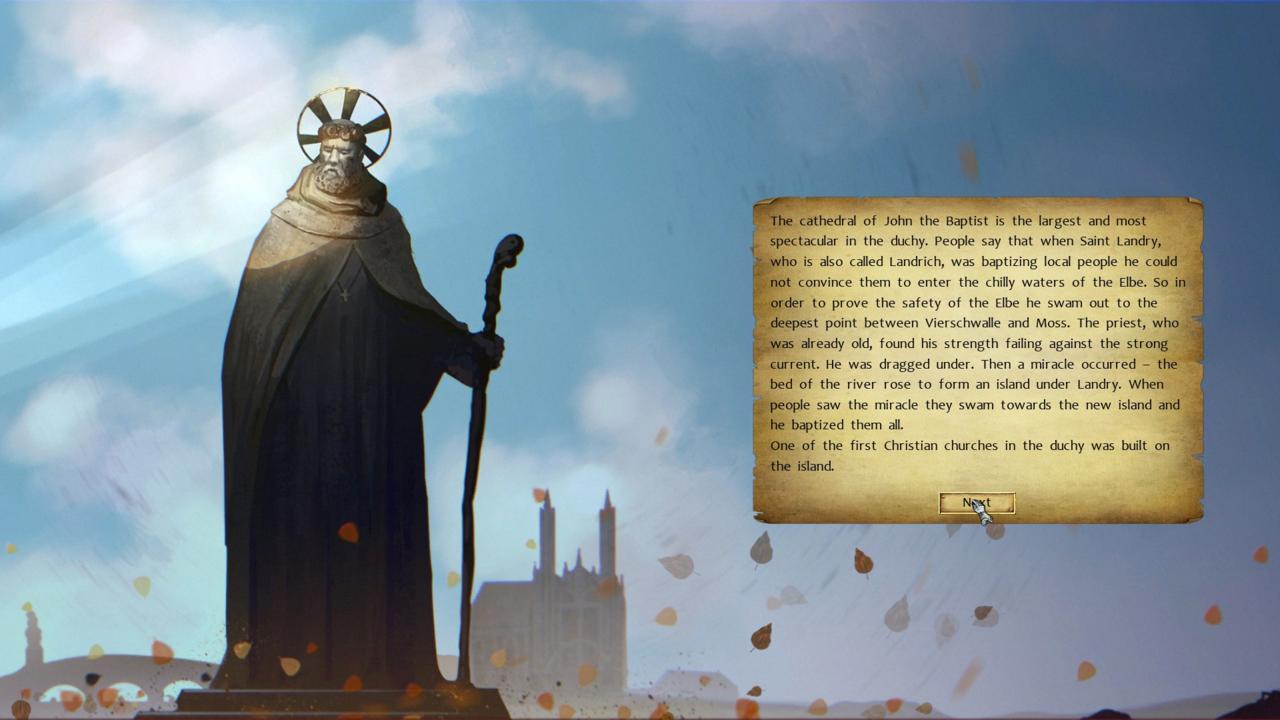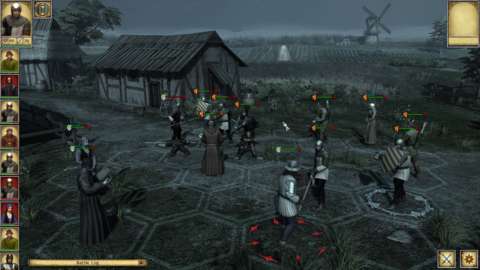Legends of Eisenwald has just about everything except Martin Luther nailing his 95 Theses on a church door. Developer Aterdux Entertainment has traded in the usual Dungeons & Dragons-influenced fantasy realm common to tactical role playing for a more realistic story and setting based on medieval Germany at around the time the Reformation was starting to annoy the popes. The concept brings a unique feel and an absorbing (if occasionally workmanlike) campaign to a been-there, done-that genre.
Nevertheless, the heart of Legends of Eisenwald is based on the same structure that has powered fantasy role-playing/tactical combat since the glory days of Heroes of Might and Magic. Differences between this game and traditional tactical fantasy role players seem rather superficial, at least at first. The three available Knight, Baroness, and Mystic character classes match up almost perfectly with the standard Warrior, Ranger, and Mage/Cleric found in standard swords-and-sorcery gaming. Both heroes and the mercenaries you employ level up and come with assorted skills, special upgrades, slots for a full range of gear and armor and weapons, and a range of stats for hit points, attack, willpower, and so forth.

Action plays out on a real-time map screen where you explore the German terrain, and a turn-based, hex-overlaid combat screen, vanquishing foes one by one. Anyone who has ever played a game in this genre will dig into what's on offer right away. Tactical combat is a bit simpler than in many similar games, in that you control a single adventure party comprised of up to 12 units instead of the multiple armies with stacks of units generally required in the likes of Heroes of Might and Magic, Disciples, and so forth. Also, you don't have to build towns, gather resources, or deal with any management tasks. This is far more of an RPG than a strategy game, with your primary focus always on exploring the maps for quests, villains, and loot.
But you aren't a good guy. You are no hero or heroine out of a D&D campaign. Instead, you're the average feudal boss, with no compunctions about working peasants to death. Modern morality has no place here--a point drilled home again and again in situations where you have to be an utter bastard. My favorite was a fairly early quest, which involved forcing peasants to repair a bridge so I could escape a pursuing enemy. First, I had to kill a bunch of them in their village. Then, I had to keep the resulting press gang on the job, even while some of them tumbled into a gorge to their deaths.
Yet even with the inclusion of plenty of 15th-century brutality, this isn't a strictly historical game. Legends of Eisenwald walks a line between "Gygax Goes German" and adherence to the history books. Maps contain more realistic landscapes than we've become accustomed to in tactical fantasy games. There are no hordes of monsters, no pots of gold, no magical resources casually cluttering up the terrain. What you get here are inns, villages, castles, ruins, mines and churches, spiced up with the occasional wandering gang of foes, such as villainous warriors and bandits.

Even though there are no orcs or unicorns, there is a little magic. While most of the units hired for your party are realistic soldiers, pikemen, archers and the like, you can also bring in support troops. Catholic priests (who look like everything from pissed-off versions of Friar Tuck to bishops or inquisitors as they level up) and pagan mystics (who at first look like zoned-out hippie chicks from The Wicker Man but progress to become either witches or abbesses) can make with the abracadabra stuff and whip out basic healing and protection spells. Artifacts like icons of Christian saints, potions, magic rings, and even special weapons and armor offer real benefits to stats. Other than this, though, fantasy is dialed down to the point of being nearly non-existent--especially in the early stages--although more mythology is introduced as the game progresses.
Oddly enough, I found that this flirtation made the game seem even more realistic. All the hints about magic and myths (including a great early sequence about a cull of the undead from a church cemetery that turns into an eviction of bandits who have been using dead bodies and cadaver stink to scare people away from their hideout) worked beautifully to make me feel like a superstitious medieval peasant who was never sure what was real and what wasn't.
The look of the game is realistic to the point of being a little on the grim side. Graphics use a dark color palette a long way from the cheery hues found in the average game with hexes and hobgoblins. Maps are incredibly detailed, no matter if the scene is a thick forest, river valley or narrow mountain canyons. Everything is a little dated, giving the visuals a sharpened and somewhat stark appearance. At times, I likened the game to a woodcut come to life. Maps are tinted with dark brown and black to make them look hundreds of years old. Character and town screens are filled with nice touches like parchment backgrounds and simple, medieval tapestry. Only the audio is a disappointment. There is no spoken dialogue to accompany the written text, and the bland lute-and-flute music sounds like something from the lobby of a Medieval hotel.


At times, however, all this realism dragged. Legends of Eisenwald lacks the pizzazz of more fantasy-oriented tactical RPGs. Loot drops just aren't that exciting when you know you're not going to score a wand of fireballs. (There is a good range of items on offer, both from defeated foes and from the markets scattered around the maps, although most of it is average stuff that lacks the glitz of what's found in traditional fantasy games.) So little magic in the game makes the priest and female mystic units bland; their being stuck mainly with healing and cursing spells means they don't have the impact of full-blown clerics and mages. Combat grows repetitive and predictable, as there are only so many ways you can mess around with garden-variety soldiers and archers. A hippogriff or a neo-otyugh might have livened things up, though the quick pace of battle means you have little time to be bored.
A few aspects of the design are somewhat problematic. Quests are not always spelled out clearly. At times this is good, as it promotes more exploration. At times this is bad, as you can get lost when a destination and/or the maps are too dark and cluttered with complicated terrain features. Some quest descriptions leave a lot to be desired, and locations are often given different names in quest dialogues from the maps. Also, be wary of bugs: I had the game crash to the desktop with exception errors on a few occasions, although generally the game was stable.
Visiting a virtual medieval Germany probably isn't at the top of the to-do list of any tactical RPGers, but maybe it should be. While Legends of Eisenwald is something of a grim, brutal experience much like the land in question back in the 15th century, the game is certainly a unique addition to a genre that has mostly settled into a high-fantasy comfort zone. Strong storytelling and sheer novelty make guiding Heinrich and his pals around the dark forests of old-time Deutschland enthralling...even if you do miss the magic missiles and elves every so often.